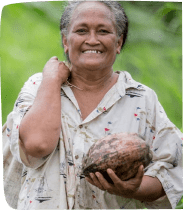Oxfam staff report people begging for food in towns worst-hit.
The Philippines is struggling to recover from last month’s massive Typhoon Rai that caused losses worth 11.1 billion Php (NZ$317.3m) to agricultural crops and farmland and another 17.5 billion Php (NZ$487.2m) damages to homes, roads, electricity and water lines.
More than 420,000 hectares of land have been lost to storm floods, and as many as 925,000 homes damaged or destroyed. Key staple crops like rice, coconut and sugarcane have been wiped out across some regions of the country. The Philippines’ fisheries industry has lost over three billion’s Php (NZ$85.6m) worth of fishing boats, gear, and stock.
Oxfam Philippines Country Director Lot Felizco said: “Our staff reported finding people begging for scraps of food in Bontoc, Padre Burgos, Tomas Oppus and Malitbog, towns that were worst hit in Southern Leyte.
“As the rest of the world starts a new year with hope, nearly 7 million people – more than the entire population of Denmark – are struggling to come to terms with their homes damaged or destroyed and main incomes gone. Nearly 390,000 farmers and fishing folk have had their crops flattened, fishing boats smashed, or livestock killed or lost. They have been left with nothing.”
Petronilo Bohol, a fisher from Malitbog village, Southern Leyte, who had already been hit by two other storms before Rai said: “We live here because our only livelihood comes from the sea. We pulled out all the boats for safety, but the waves still reached them and reached the roads. Typhoon Rai was bigger and stronger than the two previous ones. It turned our mountains bald.”
Ramon Cabarrubias, a welder from Malitbog village, Southern Leyte, told Oxfam: “[During the storm] we crowded in our bathroom thinking that it was going to be our end. The next day, we came out to nothing. My mechanic tools are gone. Even my boat disappeared”.
Typhoon Rai was the last – and by far the strongest – of fifteen typhoons to have hit The Philippines in 2021.
Extreme weather events like Typhoon Rai are harbinger of worse to come. Scientists have long warned that rising global temperatures, induced by a man-made climate crisis, are causing typhoons to become more intense more frequent.
Oxfam roundly criticised the last COP26 climate talks for showing an “appalling disregard“ of the financial plan needed to compensate countries, like the Philippines, for loss and damage. It has urged rich polluting countries to honour their promises to cut carbon emissions to avoid a catastrophic global temperature rise above 1.5C, and also to stump up funding for mitigation and adaptation – and loss and damage – to poorer countries.
Climate-fueled extreme weather events, compounded by economic fallout from Covid-19 and existing inequalities, have pushed millions of vulnerable people in the Philippines to the brink of hunger and poverty. In 2021, over 26 million people – nearly a quarter of the population – were already living under the poverty line, where families of five earn less than 12,082 Php (NZ$347) a month.
A recent survey in 2021, showed that 2.5 million Filipinos experienced involuntary hunger at least once in the three months (Jul-Sept 2021).
In the Philippines now – as local people struggle to clean up and recover their homes and livelihoods – urgent humanitarian funding is needed to provide lifesaving food and water, and to help people rebuild their homes, crops and businesses. Oxfam is urgently calling for 4 million Euros (NZ$6.7m) to help support its part of the collective humanitarian response in the country.
Notes:
- Figures on loss and damages according to Department of Agriculture – DRRM Operations Centre. As of 3 Jan 2022
- Figures on infrastructure loss and damages are according to the National Disaster Risk Reduction and Management Council (NDRRMC).
- According to 2015-2020 data from the Integrated Food Security Phase Classification, around 54.9 million or 64% Filipinos are chronically food insecure (IPC-Chronic level 2 and above). There are 14.5 million in level 3; and 7.1 million in level 4, totaling 21.6 million in IPC3 and above.
- Typhoon Rai has already killed more than 400 people, damaged nearly 830,000 houses, displaced over half a million from their homes, and left 6.8 million people in desperate humanitarian need.
- Oxfam, together with eight local partners have already reached over 38,000 people in the worst-hit communities in in Southern Leyte, Leyte province, and Siargao islands, with food packs, shelter repair materials, hygiene kits, sleeping kits, water kits, solar lights and solar packs. They also provided pre-disaster financial aid to 2,650 families in Eastern Samar to help them prepare for the typhoon.
- Data on hunger by the Social Weather Survey (SWS) reported in the 3rd quarter of 2021. http://www.sws.org.ph/swsmain/artcldisppage/?artcsyscode=ART-20211206105401
- Data on losses in agriculture and fishery sectors are from Philippines Department of Agriculture as of 6 Jan 2022






